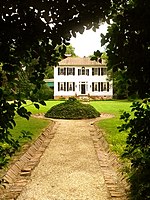1946 Greenville propane explosion
1946 disasters in the United States1946 fires in the United States1946 in South CarolinaBuilding and structure collapses caused by fireBuilding and structure collapses in the United States ... and 8 more
Disasters in South CarolinaExplosions in 1946Explosions in the United StatesGas explosionsGreenville, South CarolinaIndustrial fires and explosions in the United StatesNovember 1946 events in the United StatesUse mdy dates from July 2021
The 1946 Greenville propane explosion occurred on 19 November 1946, at the Ideal Laundry laundromat in Greenville, South Carolina. A tank containing around 3,500 US gallons (13 m3) of propane exploded around 6 PM, after leaking vapors were ignited by the boilers in the basement. The blast, which killed 6 people and injured over 150, was felt as far away as Gaffney, 50 miles to the northeast.
Excerpt from the Wikipedia article 1946 Greenville propane explosion (License: CC BY-SA 3.0, Authors).1946 Greenville propane explosion
Pete Hollis Boulevard, Greenville Downtown
Geographical coordinates (GPS) Address Nearby Places Show on map
Geographical coordinates (GPS)
| Latitude | Longitude |
|---|---|
| N 34.8603 ° | E -82.4066 ° |
Address
Pete Hollis Boulevard 101
29601 Greenville, Downtown
South Carolina, United States
Open on Google Maps










